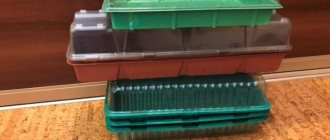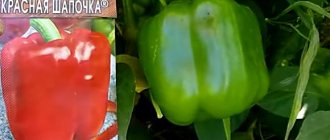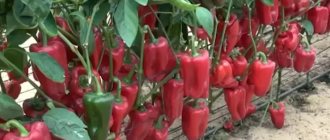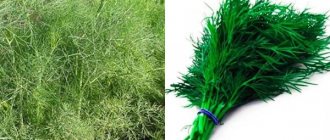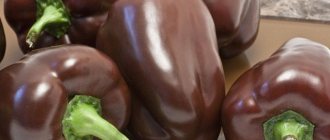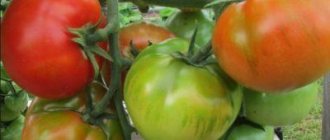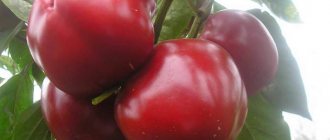Pepper Python characteristics and description of the variety
We have to thank the company of proprietary seeds “Gavrish” for the appearance of this strange and interesting hybrid on the modern market.
The characteristic features of the variety include:
- Early ripeness - no more than 125 days pass from the formation of the first shoots to the beginning of fruiting;
- This is a sweet pepper, despite the characteristic shape that is often found in hot peppers;
- The height of the bush can reach 140 cm when Python is grown in glass and film greenhouses;
- The shape of the fruit is trunk-shaped and can reach 27 cm in length;
- The average weight of the fruit is 60 g with a wall thickness of 3 mm;
- The color of the fruit changes from green to red after reaching full maturity.
Before planting, the seeds are usually germinated into seedlings, sown at the end of February and transferred to open soil by the end of May. Harvesting can begin as early as July.
Varieties of sweet long pepper
Breeders have developed a large number of different varieties of elongated sweet red peppers. They differ from each other in terms of ripening, growing regions, as well as taste and external characteristics. Let's consider varieties that can be grown in a greenhouse, as well as in open ground.
Cockatoo
The Kakadu variety is considered a hybrid and has one distinctive quality - its size. The variety got its name because of the shape of the fruit: it is somewhat similar to the elongated beak of a cockatoo. One ripe pepper can grow up to 30 cm in length, and some are even larger. In color, ripe peppers are red. The weight of one fruit is half a kilogram. The thickness of the skin reaches 7 mm.
Due to the fact that the flesh of the pepper is dense and aromatic, the vegetable can be used both canned and fresh. One bush produces up to 4 kg of fruit. Another feature of the variety is resistance to rot and tobacco mosaic. When growing, it is important to ensure that there are up to 10 fruits on one bush.
Important! Since the bushes of the Kakadu variety are very tall, they must be tied up in a timely manner so that they do not break.
Marconi
An early-ripening variety of long peppers, the bush of which reaches a height of one meter. The shape of the vegetable resembles an oblong cone. One ripe fruit reaches 200 grams in weight and 25 cm in length. The thickness of the skin is 5 mm, and the flesh is fleshy and tender. From one square meter you can harvest up to 10 kg of crop. Marconi peppers can be green or red in color, depending on the degree of ripeness.
This variety is considered one of the best in taste and commercial quality.
Orjen
In terms of height, the plant stands out for its small size, and can reach up to half a meter in height. Orien peppers have a slightly elongated, long shape. One fruit can reach 25 cm in length and 5 cm in width. The thickness of the skin is 5 mm. A ripe fruit can weigh 150 grams. Unripe peppers are yellow in color and turn red when ripe.
On average, one bush produces up to 4 kilograms. The fruits can be used for any purpose: from fresh consumption to canning. This is explained by the fact that the Orien variety has high taste.
Sweet banana
The variety got its name because of the color of the fruits: the first fruits are bright yellow. When fully ripe, the fruit acquires a red-orange hue. The plant reaches a height of 70 centimeters, which classifies it as a medium-sized variety. Having the shape of a banana, the peppers reach 20 cm in length. The thickness of the walls reaches 8 mm, and the average weight of the fruit is 250 grams. From one square meter you can collect up to 5 kg of fruit.
The advantage of the variety is the high quality of the fruit. The fruit has a delicate aroma and fleshy pulp, so it can be consumed in any form. The Sweet Banana variety withstands the main diseases that are inherent in this class of peppers.
Red elephant
The variety is a tall variety that grows up to one meter or more in height. This is a powerful semi-spreading plant. A distinctive feature of the fruits of the red elephant variety is their glossy shine. The fruits are cone-shaped. The first fruits have a greenish color, and fully ripe ones have a rich red color.
The weight of one mid-season pepper is 150 grams, length is 20 cm, the skin is 4.5 mm thick. From one square meter you can harvest up to 8 kg of crop. Red elephant fruits have aromatic and fleshy pulp.
Shepherd
A bush of this variety reaches a height of 50 cm. The weight of one fruit ranges from 220 to 270 grams, and its length reaches 25 cm. The fruits of the Shepherd variety are distinguished by their wall thickness, which can reach 1 cm. The shape of the fruit is also unusual: cone-shaped, the tip of which is slightly pointed. When unripe, peppers have a greenish or yellowish tint; when fully ripe, they acquire a reddish tint.
The Shepherd variety is excellent for canning, as the pulp is juicy and soft. It is not afraid of the main pepper diseases, especially tobacco mosaic and spotting.
Sugar cone
The variety got its name thanks to its juicy and sweet pulp. The bush of the plant grows up to 70 cm. Its distinctive feature is the strong foliage of powerful bushes. The parameters of the fruit are as follows: length - 18-19 cm, thickness of the walls and skin - 7 mm, weight of one pepper - 140 grams.
The pepper is cone-shaped and has slight ribbing. The early fruits are green, then, after full development, they become red. A distinctive feature of the Sugar Cone variety is that it produces a bountiful harvest several times in one season.
Hottabych
The variety received this name due to the fact that its fruits resemble a trunk. It belongs to the hybrid varieties and can reach a height of up to one and a half meters. The average weight of the vegetable is 110 grams, the thickness of the skin is 5 mm. The fruit has a delicate green color, which turns into a yellowish tint as it ripens. From one square meter you can harvest up to 8 kg of vegetables.
The peculiarity of the Hottabych variety is that it can be stored for a long time and at the same time, all its beneficial properties and taste will be preserved.
Mammoth tusks
This hybrid variety will surprise everyone with its huge size. Each bush grows up to one meter in height and can produce up to 13 fruits. Each fruit weighs up to 300 grams and reaches a length of 30 cm. Pepper has three colors: first green, then light yellow, and the final color is red.
A distinctive feature of the Mammoth Tusk variety is that it will always produce a good and abundant harvest, despite the climatic conditions of the region where it is grown.
Horn red
The fruits of the Horn variety are red and have a cylindrical oblong shape. They grow on bushes that reach 1 meter in height. One medium pepper weighs up to 125 grams. The color changes depending on the level of maturity: first it is green, then red. This variety has fruits that have very soft and juicy pulp.
Python
Bushes of the Python variety are tall and deciduous, reaching one and a half meters in height. The weight of one fruit is 50 grams, its length reaches 30 cm. From one square meter you can harvest up to 4 kg of crop. During the ripening process, the pepper is first green, then yellow, and the final stage is the red color of the fruit. And since the pulp is not bitter, it can be eaten at any stage of ripening.
Important! The appearance of the Piton variety is very similar to hot pepper, but it is not - this variety of pepper is sweet.
Agricultural cultivation techniques, care recommendations
It is recommended to start sowing seedlings several months before planting seedlings in open ground, in February or March.
For sowing, it is necessary to prepare in advance a fertile mixture of garden soil, ash, humus, peat and a drainage layer of sand.
After this you need:
- Disinfect the mixture by calcining it in an oven or simply pour it with a hot solution of potassium permanganate;
- Before sowing, it is also recommended to disinfect the seeds by filling them with a one percent solution of potassium permanganate, and then treating them with a mixture of a growth stimulator;
- Since pepper roots are very thin and fragile, they are easily damaged during the transplanting process. To avoid possible damage, it is recommended to immediately sow seedlings in peat tablets or separate glasses;
- It is recommended to sow seeds to a depth of no more than a centimeter, then cover the containers with seeds in a warm place, covering them with film, creating greenhouse conditions;
- After the formation of the first shoots, the containers need to be moved to the windowsill. It is important to provide sufficient lighting for 12-15 hours. If there is not enough daylight, use special lamps;
- At the two-leaf stage, transplant into separate containers;
- Planting in open soil is carried out at the rate of three plants per square meter;
- It is recommended to water the planted seedlings daily with warm, settled water. It is better to water in the morning or evening, avoiding periods of midday heat;
- Before the seedlings take root, they only need to be watered, after which you should start loosening the soil without fear of damaging the root;
- It is recommended to fertilize seedlings three to four times a season with complex mineral fertilizers containing nitrogen, potassium and phosphorus.
In addition to general care, you need to deal with the formation of the bush. All shoots up to the first fork should be cut off.
Let's watch a video about growing sweet salad peppers:
Features of agricultural technology
Seeds are sown for seedlings in late February. The material is immediately distributed into separate containers. This way they avoid picking, after which the pepper takes a long time to take root. In May, the seedlings are transferred to a permanent place. In the greenhouse, an interval of 70x70 cm is maintained. Peppers are planted one at a time in pots filled with nutritious and loose soil.
Advice. To retain moisture in the container, it is better to add a special hydrogel.
When forming, remove the leaves and side shoots that appear before the first fork of the stems. Basic care is the same as for other peppers.
Sowing seeds for seedlings | Planting seedlings in a greenhouse/greenhouse | Planting seedlings in exhaust gas | Stepsoning | Harvesting (in the greenhouse / in the greenhouse) |
| 2-3 ten days of March | Mid May | The beginning of June | After 4 sheets | End of June - July |
| *dates are indicated for central Russia | ||||
Advantages and disadvantages
In addition to its interesting shape, this hybrid is distinguished by a number of positive properties.
These include:
- It is resistant to attacks from most pepper diseases;
- Resistant to temperature fluctuations;
- With a temporary lack of moisture in the soil, the amount of harvest does not decrease;
- It has a relatively high yield of up to a kilogram per bush;
- Known for its pronounced aroma, although the taste is moderate;
- When grown on glazed balconies, the fruiting period can be extended.
Despite all the advantages of the hybrid, some users note excessively thin walls. In addition, due to its shape, Python is often confused with hot peppers.
Python pepper photos and reviews from those who grew them
In general, users who fell for the non-standard form were satisfied. So those who have grown note the convenience of growing Python on the balcony and in open ground.
The rich aroma is also not ignored, thanks to which the fruits perfectly complement salads.
In general, the reviews are positive due to the extraordinary shape, which is not typical for sweet varieties.
Gardeners express sincere surprise, because when buying seeds from a photo, they did not expect that the result would correspond to the picture.
Python pepper: what to do with it, what dishes you can cook
Due to its strong spicy odor, Python is often used as a seasoning for dishes in raw and dried form, after grinding it. In addition, you can consume the fruits fresh, cutting them into salads, complementing other vegetables of the season.
In addition to seasoning and salad dressing, this spicy pepper is used for pickling and canning.
Basically, the fruit is used as an additional ingredient, and not as an independent dish.
Python pepper has a non-standard shape for a sweet appearance and a pronounced aroma. Suitable for growing on balconies, in greenhouses and in open ground.
Late
They are perfect for greenhouses and open ground in the southern regions. Fruiting of late-ripening varieties occurs 125-130 days after emergence.
Mammoth tusks F1
This hybrid variety can surprise even the most experienced gardener with its size. On its bushes up to 1 meter high, up to 12 fruits can form simultaneously. The pepper of this hybrid grows up to 27 cm in length and weighs 300 grams. Its green color gradually and unevenly changes to bright yellow and then to red. The pepper tastes sweet, with tender and juicy flesh. It is best consumed fresh, but it is also suitable for canning.
The yield of this hybrid variety is completely independent of the soil. In addition, its plants are resistant to tobacco mosaic.
Horn red
This variety has fairly spreading bushes with a height of up to 1 meter. Its elongated fruits, weighing up to 120 grams, have the shape of a cylinder with a sharp tip. During the period of biological maturity, their color becomes bright red. The variety is distinguished by its dense and very juicy pulp with a light peppery aroma.
Horn red has good resistance to many diseases.
Python
This variety has not only long fruits, but also long bushes - up to 1.5 meters in height. They are not very leafy and semi-spreading. The Python variety stands out noticeably among other varieties. Its peppers are long – up to 27 cm and weighing up to 60 grams. The thickness of its walls will not exceed 3 mm.
Important! Piton peppers are very similar in appearance to hot peppers, but have sweet flesh.
The color of Python's long fruits changes depending on their ripeness. Green unripe fruits gradually turn red and acquire a glossy shine. A distinctive feature of Python is the absence of bitterness in the pulp of peppers. They can be consumed at any stage of ripeness, both fresh and for cooking.
The yield will be 3.8 kg of plants per square meter.

